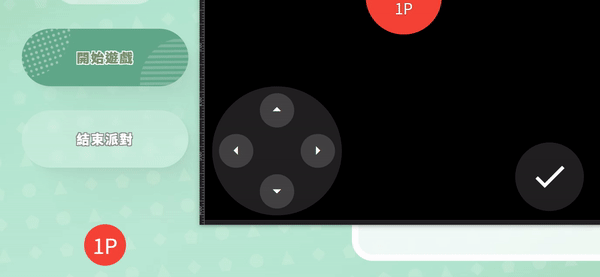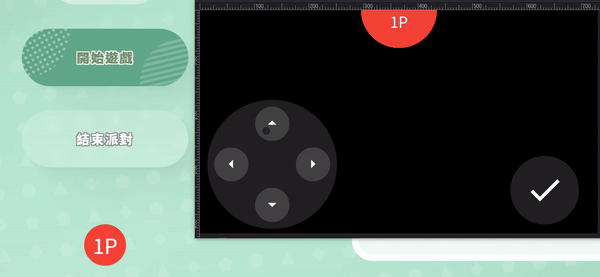本系列文已改編成書「甚麼?網頁也可以做派對遊戲?使用 Vue 和 babylon.js 打造 3D 派對遊戲吧!」
書中不只重構了程式架構、改善了介面設計,還新增了 2 個新遊戲呦!ˋ( ° ▽、° )
新遊戲分別使用了陀螺儀與震動回饋,趕快買書來研究研究吧!ლ(╹∀╹ლ)
在此感謝深智數位的協助,歡迎大家前往購書,鱈魚感謝大家 (。・∀・)。
助教:「所以到底差在哪啊?沒圖沒真相,被你坑了都不知道。(´。_。`)」
鱈魚:「你對我是不是有甚麼很深的偏見啊 (っ °Д °;)っ,來人啊,上連結!」
現在玩家出現了,訊號也進來了,讓畫面產生互動效果吧!
完派對遊戲的時候,常常發生不知道是誰在選單偷按的問題,現在讓我們在玩家頭像中,新增「說出觸發按鍵」的功能,以後誰偷按都無所遁形啦!╮(´∀` )╭
前往 player-avatar 設計說出對話泡泡的功能,首先設計資料。
src\components\player-avatar.vue
const messageInfo = reactive({
id: '',
text: '',
});
接著新增顯示與隱藏泡泡用的 function。
const hideBalloon = debounce(() => {
messageInfo.text = '';
}, 2000);
function showBalloon(text: string) {
const id = nanoid();
messageInfo.id = id;
messageInfo.text = text;
hideBalloon();
}
再新增一個映射按鈕名稱與顯示 Icon 的 function。
const keyToIcon = [
{
keyName: KeyName.UP,
icon: 'arrow_drop_up'
},
{
keyName: KeyName.LEFT,
icon: 'arrow_left'
},
{
keyName: KeyName.RIGHT,
icon: 'arrow_right'
},
{
keyName: KeyName.DOWN,
icon: 'arrow_drop_down'
},
{
keyName: KeyName.CONFIRM,
icon: 'done'
},
]
function keyNameToIconName(name: string) {
const target = keyToIcon.find(({ keyName }) => keyName === name);
return target?.icon ?? 'question_mark';
}
最後透過 defineExpose 提供外部使用。
...
<script setup lang="ts">
import { debounce } from 'lodash-es';
import { nanoid } from 'nanoid';
import { computed, reactive } from 'vue';
...
const messageInfo = reactive(...);
const hideBalloon = debounce(...);
function showBalloon(text: string) {...}
const keyToIcon = [...]
function keyNameToIconName(name: string) {...}
defineExpose({
playerId: props.playerId,
showBalloon
});
</script>
...
最後完成 template 與 CSS 內容。
<template>
<q-avatar
:color="color"
text-color="white"
size="6rem"
>
{{ props.codeName }}
<div class="balloon-box">
<transition name="balloon">
<div
v-if="messageInfo.text !== ''"
:key="messageInfo.id"
class="balloon"
>
<q-icon
color="black"
:name="keyNameToIconName(messageInfo.text)"
/>
</div>
</transition>
</div>
</q-avatar>
</template>
...
<style scoped lang="sass">
.balloon-enter-active, .balloon-leave-active
transition-duration: 0.4s
transition-timing-function: cubic-bezier(0.150, 1.535, 0.625, 1.015)
.balloon-leave-active
transition-timing-function: cubic-bezier(1.000, 0.005, 0.150, 1.005)
.balloon-enter-from, .balloon-leave-to
transform: translateY(100%) rotate(-30deg) !important
opacity: 0 !important
.balloon-leave-to
transform: translateY(100%) scale(0.4) !important
.balloon-box
position: absolute
top: 0
left: 50%
transform: translate(-50%, -100%)
width: 100%
height: 80%
.balloon
position: absolute
background: white
box-shadow: 5px 5px 10px rgba(#000, 0.1)
border-radius: 9999px
padding: 1rem 2rem
font-size: 2rem
&::before
content: ''
width: 2rem
height: 2rem
position: absolute
left: 30%
bottom: 0
transform: translateX(-40%) rotate(30deg)
background: white
box-shadow: 5px 5px 10px rgba(#000, 0.01)
</style>
以上準備好對話泡泡的功能了!( ‧ω‧)ノ╰(‧ω‧ )
現在讓我們回到大廳,實際觸發對話泡泡看看,首先透過 ref 取得所有的玩家頭像。
src\views\game-console-lobby.vue
<template>
...
<div class="absolute inset-0 flex">
<div class="flex w-full h-full">
<!-- 選單 -->
<div class="w-1/3 flex flex-col p-12">
...
<!-- 玩家清單 -->
<transition-group ... >
<player-avatar
v-for="player in playersInfo"
ref="players"
...
/>
</transition-group>
</div>
...
</div>
</div>
</template>
<script setup lang="ts">
...
const playersInfo = computed(() => { ... });
const players = ref<InstanceType<typeof PlayerAvatar>[]>([]);
...
</script>
...
接著試試看在 onGamepadData 事件中觸發 player-avatar 的 showBalloon()。

成功讓玩家說話了!◝( •ω• )◟
現在讓我們透過搖桿選擇主選單按鈕,新增 use-gamepad-navigator 用於儲存按紐並觸發相關控制。
首先制定控制元件基本介面,用來說明、限制此功能能夠支援使用的控制元件。
src\composables\use-gamepad-navigator.ts
import { ref } from 'vue';
export interface ControlElement {
click(): void;
hover(): void;
leave(): void;
isHover(): boolean;
}
export function useGamepadNavigator<T extends ControlElement>() {
const controlElements = ref<T[]>([]) as Ref<T[]>;
return {
}
}
想了解泛型加上限制的說明可以參考此連結:https://ithelp.ithome.com.tw/m/articles/10266542
接著加入各類 function。
import { computed, onMounted, Ref, ref } from 'vue';
...
export function useGamepadNavigator<T extends ControlElement>() {
...
/** hover 指定元件 */
function hoverElement(index: number) {
controlElements.value.forEach((el) => el.leave());
controlElements.value?.[index]?.hover();
}
/** 目前 hover 元件的 index */
const currentIndex = computed(() =>
controlElements.value.findIndex(({ isHover }) => isHover())
);
/** 上一個元件 */
function prev() {
if (currentIndex.value < 0) {
return hoverElement(0);
}
let targetIndex = currentIndex.value - 1;
if (targetIndex < 0) {
targetIndex += controlElements.value.length;
}
return hoverElement(targetIndex);
}
/** 下一個元件 */
function next() {
if (currentIndex.value < 0) {
return hoverElement(0);
}
const targetIndex = (currentIndex.value + 1) % controlElements.value.length;
return hoverElement(targetIndex);
}
/** 點擊目前 hover 元件 */
function click() {
if (currentIndex.value < 0) {
hoverElement(0);
return controlElements.value?.[0]?.click();
}
const targetIndex = currentIndex.value;
hoverElement(targetIndex);
return controlElements.value[targetIndex].click();
}
/** 自動 hover 第一個元件 */
onMounted(() => {
controlElements.value?.[0]?.hover();
});
return {
mountElement,
next,
prev,
click,
}
}
回到大廳中引用 use-gamepad-navigator,新增綁定元件用的 function 並綁定至想要被控制元件的 ref 中。
src\views\game-console-lobby.vue
<template>
...
<div class="absolute inset-0 flex">
<div class="flex w-full h-full">
<!-- 選單 -->
<div class="w-1/3 flex flex-col p-12">
<div class="flex flex-col flex-1 justify-center items-center gap-14">
...
<btn-base
:ref="mountElement"
label="開始遊戲"
...
>
...
</btn-base>
<btn-base
:ref="mountElement"
label="結束派對"
...
>
...
</btn-base>
</div>
...
</div>
...
</div>
</div>
</template>
<script setup lang="ts">
...
import { useGamepadNavigator } from '../composables/use-gamepad-navigator';
...
function mountElement(el: any) {
const controlElement = el as InstanceType<typeof BtnBase>;
gamepadNavigator.mountElement(controlElement)
}
...
</script>
...
會忽然發現 TypeScript 警告引數指派類型錯誤。Σ(ˊДˋ;)

這是因為 btn-base 組件對外提供的介面不符合 use-gamepad-navigator 規定的 ControlElement 介面,現在讓我們新增 btn-base 的 defineExpose,讓介面相符吧。( ´ ▽ ` )ノ
src\components\btn-base.vue
...
<script setup lang="ts">
...
import { ControlElement } from '../composables/use-gamepad-navigator';
...
defineExpose<ControlElement>({
click: handleClick,
isHover: () => state.hover,
hover: handleMouseenter,
leave: handleMouseleave,
});
</script>
...
現在回到 game-console-lobby,就會發現剛剛的錯誤消失了。ヽ(≧∀≦)ノ
現在讓我們在 onGamepadData 中呼叫 use-gamepad-navigator 的控制功能吧。
src\views\game-console-lobby.vue
...
<script setup lang="ts">
function init() {
...
gameConsole.onGamepadData((data) => {
...
if (action === 'up') {
gamepadNavigator.prev();
return;
}
if (action === 'down') {
gamepadNavigator.next();
return;
}
if (action === 'confirm') {
gamepadNavigator.click();
return;
}
});
}
init();
</script>
...
現在可以透過搖桿控制選單了!ლ(´∀`ლ)

但是有一個小問題,就是觸發 click 沒有觸發 btn-base 點擊動畫,讓我們改進一下 handleClick。
src\components\btn-base.vue
<script setup lang="ts">
...
import { promiseTimeout } from '@vueuse/core';
...
function handleClick(showEffect = false) {
emit('click');
if (showEffect) {
processClick();
}
}
async function processClick() {
state.hover = true;
state.active = true;
await promiseTimeout(200);
state.active = false;
}
...
defineExpose<ControlElement>({
/**
* @param effect 點擊效果,預設 true
*/
click(effect = true) {
handleClick(effect)
},
...
});
</script>
現在可以透過搖桿隔空觸發按鈕點擊動畫了!✧*。٩(ˊᗜˋ*)و✧*。

再來準備讓我們進入重頭戲,開發企鵝遊戲的部分了!( •̀ ω •́ )✧
以上程式碼已同步至 GitLab,大家可以前往下載:
